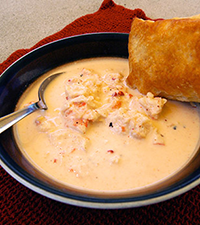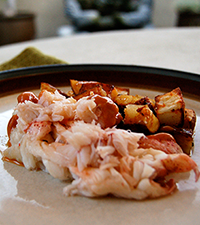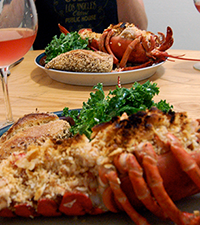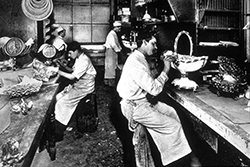I am from New England stock. (I’m tempted to call us “hearty New England stock,” but the truth is that my immediate family skews more to the side of thin, independent, and quiet weirdos. Which is its own New England archetype, I suppose.) But a childhood in New England means that certain things are in my bones: Foliage and crisp apples in the fall, cross-country skiing in the winter, fiddleheads and mud in the spring, and in summer, shell-cracking lobster dinners. To me, lobster isn’t a once-in-a-lifetime rarity or even a particularly high-class food. It’s a treat, certainly, but not the epic, caviar-level foodstuff some people make it out to be.
For people who live in America’s coastal areas, this is the way it has always been. Lobster is one of the few animals that demands being alive up to the last minute in order to ensure the best taste. That means that for those inland, having lobster meant being able to pay more for special shipping and care; and that in lobster-fishing areas, eating the stuff was shrug-worthy.
However, that doesn’t mean that those who had easy access to the crustacean hated its (literal) guts. This might surprise you; one of the most prevalent rumors about lobster in America is that it was once considered so awful that even prisoners shunned it. This rumor was perhaps most famously perpetrated by David Foster Wallace in his epic essay “Consider the Lobster,” an exploration of the ethics of lobster eating. In the piece, Wallace noted that lobster was “eaten only by the poor and institutionalized. Even in the harsh penal environment of early America, some colonies had laws against feeding lobsters to inmates more than once a week because it was thought to be cruel and unusual, like making people eat rats.”
Well, DFW lied to you. In his book Lobster, Richard J. King says that, “Food historian Sandy Oliver wrote that she has never found nor heard of a single primary document of one of these complaints or ordinances against eating lobster.” In fact, lobster has been considered a viable – and even luxury – foodstuff for thousands of years. There are Greek and Roman references to eating lobster; in Lobster: A Global History, writer Elizabeth Townsend notes that lobster recipes show up in Medieval Europe as early as the 1300s. And people certainly saw lobster as something special — in his book, King points out that lobster has long been considered an aphrodisiac. (Then again, he also points out that one of the poets who waxed on lobster’s romantic and sexual powers in the 1700s also wrote about sending his lady love another supposed aphrodisiac, a lamprey. Considering that lampreys look like detached penises with the mouth of the sarlacc at the end, I’m not sure if I trust his thoughts on food and romance.)
So there were no laws about feeding lobsters to inmates. But what was true was that for many years, coastal Americans found lobster to be an unappetizing bore; they simply had so much of the stuff that they were sick of it. (In this way, lobster was to coastal colonial Americans what Jose Cuervo is to so many college students today.)
Around the mid 1800s, though, lobster demand increased. Tourists flocked to Maine for fresh air and seafood, and canning methods were perfected that allowed lobster to be preserved and shipped all across the country. That’s why we still see cans and cans of lobster stacked next to tuna on grocery store shelves today. Oh, wait – we don’t see that? Yeah. That’s because canned lobster tastes kinda gross. In 1901’s The Art of Canning and Preserving as an Industry, author Jean Pacrette notes:
…after a few months the canned lobster takes the often unpleasant taste which cannot be otherwise described than canned lobster taste. Everybody knows this taste of which we cannot speak without an instinctive and peculiar contraction of the muscles of the face.
Still, I will note that this was an improvement over previous methods of preserving lobster, including wrapping it in rags and burying it on the beach. Because if there’s one thing I feel is missing in my life, it’s eating old shellfish wrapped in rags.
But the mediocrity of canned lobster didn’t stop people from consuming it. This rise in demand, coupled with a growing class of wealthy people who could afford to have fresh lobster shipped to cities like New York and Philadelphia, ushered in the real era of luxury lobster in America. As Townsend puts it, “Where sauce was once used to disguise lobster, it now dressed up the distinguishable meat into dreamy, prestigious dishes.”
This, to me, is the ultimate sign of luxury and wealth: Not only can you afford an expensive ingredient — one that is recognized as oh-so-good with just a bit of butter — but that you don’t mind burying the flavor of that ingredient in rich sauces. It treats the ingredient more like a mysterious, difficult cut of beef that you’re trying to hide the flavor of.
Perhaps the most famous of these late 1800s and early 1900s luxury lobster dishes is Lobster Newberg. It was created at the famed Delmonico’s restaurant, one of America’s first fine-dining establishments – the type that had an epic, multi-page menu. As the Glouster Times in Glouster, MA reported:
In 1876, Ben Wenberg, a wealthy sea captain who frequented Delmonico’s told…about a way to cook lobster with a secret ingredient. Under Wenberg’s supervision, the lobster was prepared with cream, butter, sherry, egg yolk and a pinch of cayenne, the so-called mysterious ingredient. The dish turned out to be such a hit that it was named Lobster Wenberg and added to the menu.
Then, after a spat with Wenberg, the restaurant changed the dish’s name to Newberg.
There are several similar dishes from the era that echo this Wenberg/Newberg style. Lobster Thermidor contains similar ingredients, but is generally served flamboyantly in the lobster’s shell. Another recipe is Lobster Victoria, which calls for lobster meat to be mixed with parsley, mushrooms, and onions; then chopped into cutlets and fried. In her famous Boston Cooking-School Cook Book, Fannie Farmer even includes separate recipes for “Lobster a la Newberg” and “Lobster a la Delmonico.” The subtle difference in Farmer’s versions is that the Delmonico dish includes a bit of flour for thickening, and Newberg includes brandy as well as sherry.
Lobster Victoria also has a tie to Delmonico’s. In the late 1800s, Delmonico’s vacated its previous space at 5th Avenue and 26th St in New York City, and Cafe Martin took its place. Cafe Martin was one of many so-called “lobster palaces” of the era – restaurants and show spaces in the Times Square and Broadway areas that were known for decadence. But despite the name, lobster was far from the focus. (A 1904 menu from Cafe Martin only has one lobster dish – the aforementioned Lobster Victoria.) Rather, in 1909 article from Putnam’s and the Reader called “New York at the Table,” the author notes:
But nobody of distinction of appetite goes to a lobster palace to eat. One goes there in gaudy mood or when every other place is filled or closed or with the kind of man who thinks gayety means overdressed women bediamonded men waiters rushing with champagne as if they had the fire buckets and a caterwauling orchestra that repeats the George M Cohan music every fifteen minutes.
Basically, lobster palaces were the day’s equivalent of douchey Vegas clubs. (And I can only assume that Cohan — who wrote several popular songs songs including “You’re a Grand Old Flag” and “Give My Regards to Broadway” — was that era’s Pitbull.)
But just as one day Pitbull will (hopefully) hopefully fall off the Billboard charts, these rich, epic lobster dishes have fallen out of favor. Sure, you’ll still see them on some menus — especially at restaurants that keep old-school dining traditions alive. The dark-wood paneled Hollywood dining institution Musso & Frank still offers Lobster Thermidor, for example.
And for a New England girl such as myself who doesn’t consider lobster an absolute luxury, these dishes are. That’s why, at Christmas, my family will break out my grandmother’s Lobster Newberg recipe. We simmer the lobster in its rich sauce, splash it with a bit of sherry, and eat like kings — or, at the very least, like lobster palace nouveau riche. • 5 July 2013
| GRAMMY FAVREAU’S LOBSTER NEWBERG, |
 My grandmother’s recipe isn’t the truest to the original. Hell, it includes a secret ingredient of American cheese – arguably my least favorite of all cheeses and cheese products. But last year around Christmastime, my family had both a more traditional Newberg and my grandmother’s recipe, and my dad and I agreed that my grandmother’s was superior. This is one of those recipes where almost everything is to taste, so have a spoon handy. My grandmother’s recipe isn’t the truest to the original. Hell, it includes a secret ingredient of American cheese – arguably my least favorite of all cheeses and cheese products. But last year around Christmastime, my family had both a more traditional Newberg and my grandmother’s recipe, and my dad and I agreed that my grandmother’s was superior. This is one of those recipes where almost everything is to taste, so have a spoon handy.
|
| LOBSTER K.C.B. |
 I don’t know what it is about lobster dishes that apparently inspires writing the recipe as a long list, but here’s another one. It comes from one of my favorite old-cookbook specimens, 1922’s The Stag Cook Book: Written for Men by Men. It includes recipes from several famous men including Charlie Chaplin, Harold Lloyd, and Rube Goldberg. This recipe comes from Kenneth C. Beaton (hence “K.C.B.”), a writer and actor. I don’t know what it is about lobster dishes that apparently inspires writing the recipe as a long list, but here’s another one. It comes from one of my favorite old-cookbook specimens, 1922’s The Stag Cook Book: Written for Men by Men. It includes recipes from several famous men including Charlie Chaplin, Harold Lloyd, and Rube Goldberg. This recipe comes from Kenneth C. Beaton (hence “K.C.B.”), a writer and actor.
There are two changes I suggest making to this recipe based on my testing. First, ignore the walnut catsup. Well, unless you want to find green walnuts and give yourself a bit of a challenge (they are in season right now, after all). Ingredient-wise, walnut catsup is actually somewhat similar to the already included Worcestershire sauce, so excluding it isn’t a big deal. Secondly, I found that the pain of broiling the lobster (as opposed to boiling or steaming) wasn’t really worth it. I suggest simply boiling it and removing the meat. As for the potatoes, I roasted mine with a bit of salt, pepper, and smoked paprika, and they were an excellent accompaniment.
|
| LOBSTER (COLLOPS OF) IN THE SHELL |
 I like this recipe from 1830’s The Cook’s Dictionary and House-keeper’s Directory because it has a bit of the vibe of stuffed lobster, thanks to a coating of breadcrumbs (or, if you wish, Ritz crackers – a popular lobster-stuffing ingredient) on top and the serve-in-shell presentation of Thermidor, but it also keeps the lobster meat itself pretty pure. Ignore the call for veloute; a splash of white wine does just as well without the pain of whipping up a sauce. For the salamander instruction, simply place the dish under the broiler until it browns a bit. I like this recipe from 1830’s The Cook’s Dictionary and House-keeper’s Directory because it has a bit of the vibe of stuffed lobster, thanks to a coating of breadcrumbs (or, if you wish, Ritz crackers – a popular lobster-stuffing ingredient) on top and the serve-in-shell presentation of Thermidor, but it also keeps the lobster meat itself pretty pure. Ignore the call for veloute; a splash of white wine does just as well without the pain of whipping up a sauce. For the salamander instruction, simply place the dish under the broiler until it browns a bit.
|




